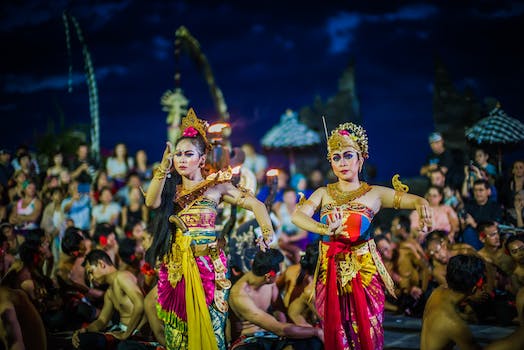-
Table of Contents
“Explore the World’s Rich Cultural Heritage – Cultural Exploration with Nishankhatri.xyz!”
Introduction
Welcome to Cultural Exploration: Discovering Traditions Around the Globe! This website is dedicated to exploring the fascinating cultures of the world. Here, you will find information about the customs, beliefs, and traditions of different countries and regions. We will explore the history, art, music, food, and language of each culture, as well as the unique aspects that make them special. We will also discuss the challenges and opportunities that come with cultural exchange. So, join us on this journey of discovery and learn more about the world around us!
Exploring the Cultural Traditions of India

India is a country with a rich and vibrant culture that has been shaped by its long history and diverse population. From the ancient Indus Valley civilization to the modern day, India has a long and varied cultural heritage that is reflected in its art, literature, music, dance, and cuisine.
The culture of India is a mix of various influences from its past, including Hinduism, Buddhism, Jainism, Sikhism, and Islam. This mix of cultures has created a unique and vibrant culture that is celebrated around the world.
One of the most important aspects of Indian culture is its religious beliefs and practices. Hinduism is the predominant religion in India, and it is the basis for many of the country’s cultural traditions. Hinduism is a polytheistic religion that believes in the existence of multiple gods and goddesses, and it is based on the Vedas, a collection of ancient texts.
The practice of yoga is also an important part of Indian culture. Yoga is a form of physical and mental exercise that originated in India and is now practiced around the world. It is believed to help promote physical and mental well-being, and it is often used as a form of meditation.
Indian cuisine is another important part of the country’s culture. Indian food is known for its use of spices and herbs, and it is often cooked in a variety of ways. Indian cuisine is also known for its vegetarian dishes, which are popular among many Indians.
Indian music and dance are also important aspects of the country’s culture. Indian music is often based on classical Indian ragas, and it is often accompanied by traditional Indian instruments such as the sitar and tabla. Indian dance is also an important part of the culture, and it is often used to tell stories or express emotions.
India is also known for its vibrant art and literature. Indian art is often colorful and intricate, and it often depicts scenes from Hindu mythology. Indian literature is also rich and varied, and it includes works from ancient Sanskrit texts to modern novels.
India is a country with a rich and vibrant culture that has been shaped by its long history and diverse population. From its religious beliefs and practices to its art, literature, music, dance, and cuisine, India has a unique and vibrant culture that is celebrated around the world.
Exploring the Cultural Traditions of China
China is a country with a rich and vibrant culture that has been around for thousands of years. From its ancient traditions to its modern customs, the culture of China is unique and fascinating. In this blog post, we’ll explore some of the cultural traditions of China that have been passed down through generations.
One of the most important cultural traditions in China is the practice of ancestor worship. This practice is rooted in the belief that the spirits of deceased ancestors can influence the lives of their descendants. As such, Chinese people often pay their respects to their ancestors by offering food, burning incense, and performing rituals.
Another important cultural tradition in China is the practice of Confucianism. This philosophy is based on the teachings of the ancient Chinese philosopher Confucius and emphasizes the importance of respect, loyalty, and filial piety. Confucianism is still widely practiced in China today and is seen as a cornerstone of Chinese culture.
Chinese people also have a strong tradition of martial arts. Martial arts have been practiced in China for centuries and are seen as a way to cultivate physical and mental strength. Martial arts such as kung fu, tai chi, and wushu are still popular in China today and are often used for self-defense, exercise, and competition.
Finally, Chinese people have a long tradition of celebrating festivals. These festivals are often based on the lunar calendar and are celebrated with parades, fireworks, and other festivities. Some of the most popular festivals in China include the Chinese New Year, the Dragon Boat Festival, and the Mid-Autumn Festival.
These are just a few of the many cultural traditions of China. From ancestor worship to martial arts, Chinese culture is full of fascinating customs and beliefs that have been passed down through generations. Whether you’re interested in learning more about Chinese culture or just want to experience it firsthand, there’s no better way to do so than by exploring its many cultural traditions.
Exploring the Cultural Traditions of Japan
Japan is a country steeped in culture and tradition. From its ancient Shinto and Buddhist religions to its traditional arts and crafts, Japan has a rich and vibrant history that is still celebrated today. In this blog post, we’ll explore some of the cultural traditions of Japan and how they are still practiced today.
One of the most important cultural traditions in Japan is the tea ceremony. This ritual dates back to the 15th century and is still practiced today. The tea ceremony is a way of expressing respect and appreciation for the tea and the people who are sharing it. During the ceremony, the host will prepare and serve the tea in a special way, using a variety of utensils and tools. The guests will then drink the tea and appreciate its flavor and aroma.
Another important cultural tradition in Japan is the art of origami. Origami is the art of folding paper into intricate shapes and designs. It is believed to have originated in Japan in the 17th century and is still practiced today. Origami is often used to create decorations for special occasions, such as weddings and birthdays.
The Japanese also have a long tradition of martial arts. Martial arts such as judo, karate, and aikido have been practiced in Japan for centuries. These martial arts are still popular today and are used for self-defense, competition, and physical fitness.
Finally, the Japanese have a long tradition of calligraphy. Calligraphy is the art of writing characters in a beautiful and artistic way. It is believed to have originated in China but was adopted by the Japanese in the 8th century. Calligraphy is still practiced today and is often used to decorate homes and businesses.
These are just a few of the many cultural traditions of Japan. From tea ceremonies to martial arts, Japan has a rich and vibrant culture that is still celebrated today. Whether you’re interested in learning more about the culture or just want to experience it firsthand, Japan is a great place to explore.
Exploring the Cultural Traditions of Mexico
Mexico is a country with a rich and vibrant culture that has been shaped by its history and its people. From its ancient Aztec and Mayan civilizations to its colonial Spanish influences, Mexico has a unique cultural heritage that is celebrated around the world. From its vibrant music and art to its traditional cuisine and festivals, Mexico has something to offer everyone.
Music is an integral part of Mexican culture, with traditional styles such as mariachi, ranchera, and norteño being popular throughout the country. Music is often used to celebrate special occasions, such as weddings and religious festivals. Traditional instruments such as the guitar, vihuela, and harp are also popular.
Mexican art is also highly celebrated, with many traditional styles such as muralism, folk art, and religious art being popular. Mexican art often reflects the country’s history and culture, with many pieces depicting scenes from everyday life.
Mexican cuisine is also a major part of the country’s culture. Traditional dishes such as tacos, enchiladas, and tamales are popular throughout the country. Mexican cuisine is often spicy and flavorful, with many dishes featuring a variety of chilies and spices.
Festivals are also an important part of Mexican culture. From the Day of the Dead to Cinco de Mayo, there are many festivals throughout the year that celebrate Mexican culture and history. These festivals often feature traditional music, dancing, and food.
Mexico is a country with a rich and vibrant culture that is celebrated around the world. From its traditional music and art to its delicious cuisine and festivals, Mexico has something to offer everyone. Whether you’re looking to explore its ancient history or experience its modern culture, Mexico is sure to have something for you.
Exploring the Cultural Traditions of South Africa
South Africa is a country with a rich and diverse cultural heritage. From the traditional music and dance of the Zulu people to the vibrant art and cuisine of the Cape Town region, South Africa has something to offer everyone. In this blog post, we’ll explore some of the cultural traditions of South Africa and how they have shaped the country’s identity.
One of the most iconic cultural traditions of South Africa is the Zulu dance. This traditional dance is performed by the Zulu people of KwaZulu-Natal and is characterized by its energetic movements and vibrant costumes. The Zulu dance is often accompanied by traditional music, which is usually played on drums and other percussion instruments. The Zulu dance is a symbol of unity and celebration, and it is often performed at weddings and other special occasions.
The Cape Town region of South Africa is known for its vibrant art and cuisine. The city is home to a variety of art galleries, museums, and cultural centers that showcase the work of local artists. The city is also known for its unique cuisine, which is a mix of African, Dutch, and British influences. Popular dishes include bobotie (a spicy meat pie), sosaties (skewered meat), and malva pudding (a sweet dessert).
South Africa is also home to a variety of traditional music styles. The most popular style is mbaqanga, which is a mix of traditional African music and jazz. Other popular styles include kwela (a type of street music) and maskandi (a type of folk music). These styles are often performed at festivals and other events throughout the country.
Finally, South Africa is home to a variety of traditional sports. Soccer is the most popular sport in the country, but other popular sports include rugby, cricket, and netball. These sports are often played in stadiums and other public venues, and they are a great way to experience the culture of South Africa.
South Africa is a country with a rich and diverse cultural heritage. From the traditional music and dance of the Zulu people to the vibrant art and cuisine of the Cape Town region, South Africa has something to offer everyone. Whether you’re looking to experience the country’s traditional music and dance, its vibrant art and cuisine, or its traditional sports, South Africa has something for everyone.
Conclusion
Cultural Exploration: Discovering Traditions Around the Globe is an invaluable resource for anyone interested in learning more about the world’s diverse cultures. It provides an in-depth look at the customs, beliefs, and practices of different cultures, allowing readers to gain a better understanding of the world around them. By exploring the different cultures, readers can gain a greater appreciation for the beauty and complexity of the world and its people.
















